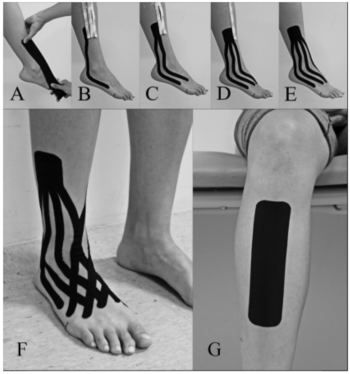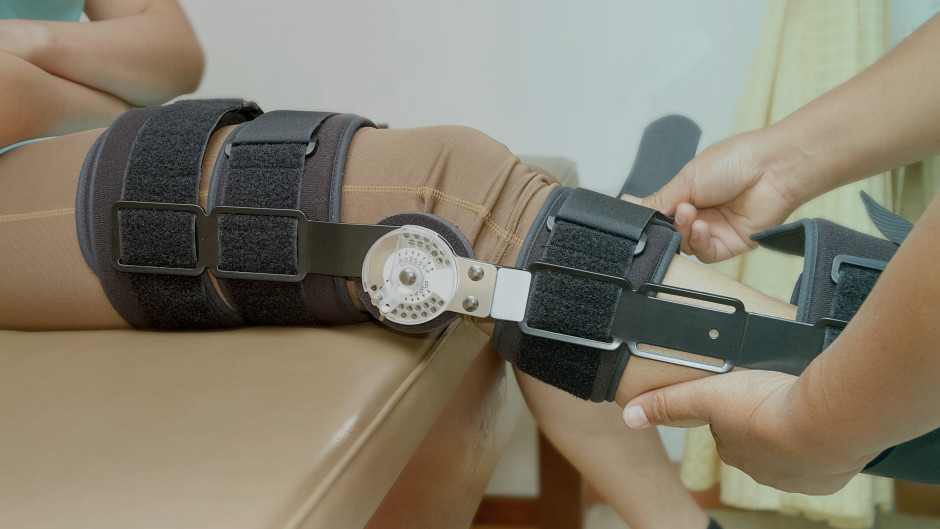The Last Blog On Kinesiotape You Will Ever Need To Read
Let’s get this out of the way upfront: kinesiotape doesn’t work. I really, really wish it did though. I wish it could solve all of my patients’ problems. I wish I could instantly get my patients out of pain. I wish kinesiotaping was a marketable skill that would set me apart. I have used it in the clinic, too. Patients have even told me they feel better with it on. But the science on kinesiotape has unassumingly quelled my hopes.
Kinesiotape is athletic tape that can be cut into strips and worn on different parts of the body. It’s marketed towards active people and is purported to help with managing injuries and improving your abilities. Many companies make it and claim to have the best version, but it really is all the same stuff: just stretchy, elastic tape that comes in different colors and can be cut into different shapes. You can put it anywhere you want, to address any goal you want, and you can easily learn how to do it yourself.
The Recommended Uses
According to the original kinesiotape manufacturers, the tape helps to lift the skin, target somatosensory receptors in your body, and improve blood and lymphatic flow. While this may sound sophisticated and science-y, drilling down on exactly what kinesiotape does leaves you feeling unsatisfied. There really isn’t any consensus on how exactly kinesiotape “works,” and the available science doesn’t make it any clearer.
Healthcare practitioners and the general public utilize kinesiotape for many different purposes, but most commonly among them are reducing pain, improving strength and range of motion, reducing the risk of injury, supporting a current injury, or improving performance. Kinesiotape has exploded, thanks to aggressive marketing and enticing claims about its benefits from its purveyors.
Most notably, kinesiotape was heavily featured at the 2008 and 2012 Olympics after a big push from its manufacturers, with many athletes displaying complex taping patterns and misplaced confidence. What the manufacturers won’t tell you though, is on the majority of fairly designed and adequately controlled scientific tests, kinesiotape has failed.
A Quick Review Of The Scientific Evidence
The most comprehensive and broad scientific reviews on the subject have failed to find anything exciting. A considerable number of reviews that all include multiple studies on their own have reported no substantial, durable results we can be confident in.
Many reviews found that kinesiotape can relieve pain (4, 5, 7, 8, 9, 11, 13, 16), but these effects are so small that they are negligible in real life, and not better than anything else you could do for pain. There is no convincing evidence that kinesiotape can improve strength (2, 5, 8). The evidence showing that it can prevent injuries, or improve your performance isn’t there either (10, 15).
There are some studies that have focused on Lymphedema, a disorder associated with swelling in the arms and legs due to blockages in the lymphatic system. Kinesiotape does seem to help a bit here…but not any better than treatments that healthcare practitioners already do (3, 6). Other studies found mixed results or poor quality research.
Curious Placebo-Controlled Studies
In medical research, placebo-controlled trials are the gold standard way to test our treatments. In physical therapy and musculoskeletal medicine, these trials are a bit harder to conduct because our treatments are not as easily simulated as a medication. But when researchers get creative with their designs, we get interesting studies that can challenge our biases. Here are a few studies that should make you reconsider your thoughts on kinesiotape.
One study from 2016 enrolled 33 people who knew nothing about kinesiotape and the researchers assessed hand grip strength. Under the pretense of applying muscle sensors, the researchers taped each blindfolded subject in one of two ways, or they applied no tape at all. The first way was the prescribed method to enhance muscle strength, and the second was designed to inhibit it. Each group performed the same on the grip strength test before and after taping, suggesting the tape had no effect one way or the other (1). If kinesiotape really could enhance or inhibit muscle activity, this would be the study to detect it. Kinesiotape failed. A few of the same authors replicated the study while measuring leg strength, and found the same results (14).
Another study from 2015 looked at ankle swelling. If you have seen any pictures of kinesiotaping on social media, you have no doubt seen the fancy spider web pattern that purportedly reduces swelling. It looks cool, I admit. It would be even cooler if it actually reduced swelling any better than a sham taping, but it doesn’t (12).

The recommended taping for swelling on the left, versus sham taping on the right. It was not effective. (Nunes 2015)

Overhyped And Under-Scienced
Where does this leave us? To put it bluntly; kinesiotape cannot do what kinesiotape companies say it can do. The strongest (strongest is a relative term here) research shows kinesiotape can reduce pain by small amounts for a short period of time, but not better than anything else. No other claims about kinesiotape have ever been substantiated and most have been disproven outright. The results people report can be attributed to the small amount of pain relief that occurs, and nothing more. Most people that recommend kinesiotape suggest it is only one part of a treatment, and works best in conjunction with other things. But this is nonsense too and only serves as a way to hedge their bets and make a claim that is easier to defend. There is a reason one kinesiotape manufacturer was unable to defend its claims about their product and reached a settlement in a class action lawsuit.
At best, kinesiotape purveyors are looking at the scientific evidence and being overly optimistic and uncritical. At worst, they are ignoring the scientific evidence, or lying about it. Both are unacceptable and misleading. The phenomenon of kinesiotape illustrates how a medical product can be created and marketed with great success, despite evidence it doesn’t really work. The dichotomy of the anecdotal success and scientific failure of the latest medical treatments is worthy of a future blog on its own.


Let me enlarge the small print for you: *NOT CLINICALLY PROVEN FOR ALL INJURIES*
Don’t Waste Your Time Or Money
Kinesiotape, from a scientific standpoint, belongs buried in the graveyard of failed medical treatments. It has died a slow and painful death over the last decade, but every now and then an article in popular media, or an eager and well-meaning physical therapist might try and resurrect it. It might seem like a plausible way to help your situation. The marketing materials might be convincing. You might feel it helping you for a day or two. Someone might even be able to cite a study that casts kinesiotape in a positive light. But don’t be fooled. The broad scientific picture suggests that kinesiotape doesn’t really work the way we all want it to, and we need to stop trying to dig it up.
You can check out Nick's website and the original post HERE.
Get 20% off for the yearly membership with the discount code: EASTER2022
If you want to stay up to date and keep learning high quality information as a therapist, then a subscription to Trust me-ED, the "Netflix for Physiotherapists" would be great for you. You can watch a new lecture every two weeks, made by experts in our field.
You can sign up today and join the growing community of therapists who strive to be better here:
References
- Cai, C., et al. “Facilitatory and Inhibitory Effects of Kinesio Tape: Fact or Fad?” Journal of Science and Medicine in Sport, vol. 19, no. 2, 2016, pp. 109–112., doi:10.1016/j.jsams.2015.01.010.
- Csapo, Robert, and Luis M. Alegre. “Effects of Kinesio® Taping on Skeletal Muscle Strength—A Meta-Analysis of Current Evidence.” Journal of Science and Medicine in Sport, vol. 18, no. 4, 2015, pp. 450–456., doi:10.1016/j.jsams.2014.06.014.
- Gatt, M., et al. “A Meta-Analysis of the Effectiveness and Safety of Kinesiology Taping in the Management of Cancer-Related Lymphoedema.” European Journal of Cancer Care, vol. 26, no. 5, 2016, doi:10.1111/ecc.12510.
- Júnior, Maurício Antônio Da Luz, et al. “Effectiveness of Kinesio Taping in Patients With Chronic Nonspecific Low Back Pain.” Spine, vol. 44, no. 1, 2019, pp. 68–78., doi:10.1097/brs.0000000000002756.
- Kalron, Alon, Bar-Sela S. “A systematic review of the effectiveness of Kinesio Taping® – Fact or fashion?.” European Journal Of Physical And Rehabilitation Medicine, vol. 49, no. 5, 2013, pp. 699–709.
- Kasawara, Karina Tamy, et al. “Effects of Kinesio Taping on Breast Cancer-Related Lymphedema: A Meta-Analysis in Clinical Trials.” Physiotherapy Theory and Practice, vol. 34, no. 5, 2018, pp. 337–345., doi:10.1080/09593985.2017.1419522.
- Lim, Edwin Choon Wyn, and Mathew Guo Xiang Tay. “Kinesio Taping in Musculoskeletal Pain and Disability That Lasts for More than 4 Weeks: Is It Time to Peel off the Tape and Throw It out with the Sweat? A Systematic Review with Meta-Analysis Focused on Pain and Also Methods of Tape Application.” British Journal of Sports Medicine, vol. 49, no. 24, 2015, pp. 1558–1566., doi:10.1136/bjsports-2014-094151.
- Lu, Zhijun, et al. “Kinesio Taping Improves Pain and Function in Patients with Knee Osteoarthritis: A Meta-Analysis of Randomized Controlled Trials.” International Journal of Surgery, vol. 59, 2018, pp. 27–35., doi:10.1016/j.ijsu.2018.09.015.
- Montalvo, Alicia M., et al. “Effect of Kinesiology Taping on Pain in Individuals With Musculoskeletal Injuries: Systematic Review and Meta-Analysis.” The Physician and Sportsmedicine, vol. 42, no. 2, 2014, pp. 48–57., doi:10.3810/psm.2014.05.2057.
- Mostafavifar, Mehran, et al. “A Systematic Review of the Effectiveness of Kinesio Taping for Musculoskeletal Injury.” The Physician and Sportsmedicine, vol. 40, no. 4, 2012, pp. 33–40., doi:10.3810/psm.2012.11.1986.
- Nelson, Nicole L. “Kinesio Taping for Chronic Low Back Pain: A Systematic Review.” Journal of Bodywork and Movement Therapies, vol. 20, no. 3, 2016, pp. 672–681., doi:10.1016/j.jbmt.2016.04.018.
- Nunes, Guilherme S, et al. “Kinesio Taping Does Not Decrease Swelling in Acute, Lateral Ankle Sprain of Athletes: a Randomised Trial.” Journal of Physiotherapy, vol. 61, no. 1, 2015, pp. 28–33., doi:10.1016/j.jphys.2014.11.002.
- Parreira, Patrícia Do Carmo Silva, et al. “Current Evidence Does Not Support the Use of Kinesio Taping in Clinical Practice: a Systematic Review.” Journal of Physiotherapy, vol. 60, no. 1, 2014, pp. 31–39., doi:10.1016/j.jphys.2013.12.008.
- Poon, K.y., et al. “Kinesiology Tape Does Not Facilitate Muscle Performance: A Deceptive Controlled Trial.” Manual Therapy, vol. 20, no. 1, 2015, pp. 130–133., doi:10.1016/j.math.2014.07.013.
- Reneker, Jennifer C., et al. “Effectiveness of Kinesiology Tape on Sports Performance Abilities in Athletes: A Systematic Review.” Physical Therapy in Sport, vol. 31, 2018, pp. 83–98., doi:10.1016/j.ptsp.2017.10.001.
- Vanti, C., et al. “Effect of Taping on Spinal Pain and Disability: Systematic Review and Meta-Analysis of Randomized Trials.” Physical Therapy, vol. 95, no. 4, 2014, pp. 493–506., doi:10.2522/ptj.20130619.



